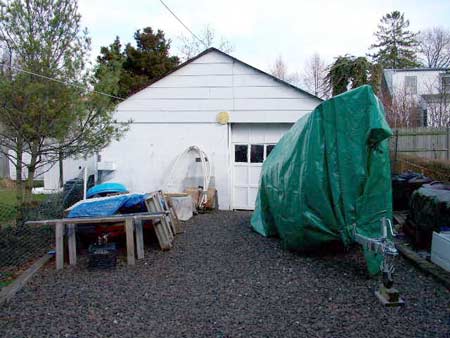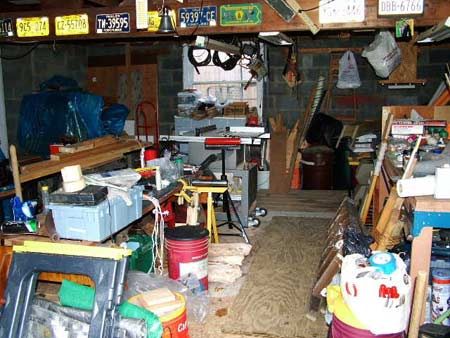‘Ah, Spring . . . When a Man’s Fancy turns to . . . ’
Winter probably had it’s last gasp, for this year. The ‘official’ first day of spring was five days ago. However, a look outside tells me that ‘Ma Nature’ still has a few things to say. Tomorrow is the ‘Easter Brunch’ at the Dragon . . . with 50 degrees, breezy, and ‘partly cloudy’ forecast. An ‘Egg Hunt’ & other outdoor activities are planned. Hopefully we won’t get too much ‘partly cloudy’ falling.
All in all, I think this winter hasn’t been too bad.. From the lack of the typical acrimonious and heated arguments, there wasn’t much ‘cabin fever’ about. Anyhow, everyone seems to be in the ‘take the covers off the tools, and dust off the plans’ mode. I’ve had a ‘system crash’ so may have missed a few things, but the latest ‘activity’ seems to cover a relatively wide range. From the basic ‘BUDGET’ boatbuilding, to the rather esoteric ‘KEVLAR application’. And, of course, that perenniall favorites . . . ‘Polyester vs Epoxy’ and ‘Marine Ply vs Others’.
I used to have three big limitations to my efforts. While I now have the ‘TIME’, the others are still in force . . . Workspace and MONEY. I’ve got just about all the tools I need, but it would be fantastic to have a 30x60 ‘poured pad’ with one of those modular steel buildings on it. It would be ‘romantic’ to have a duplicate of the ‘Small Boat Shop’ at Mystic Seaport. However, nothing like that is likely to occur. I don’t have the room, and the cost of simply ‘carrying away’ the refuse of my torn-down shop would equal the cost of an equal-sized modular building !!


Therefore, the need for planning and a lot of thoughts about ‘appropriate quality’.
With engineering, there is an ‘insider’ comment about ‘Gold Plating’ a solution to a problem. It means going over something again and again and again, etc., to try to obtain a ‘perfect’ solution. This is usually at odds with the reality of manufacturing or completion schedules. A good ‘practical’ or application engineer {which I was}, has a focus on ‘get the product out the door so we’ll get PAID!’. The writer, boat designer/builder, and scrounger extrodinare George Buehler is a great example. A more immediate example is the news shot of the fisherman who lost their boats in the tsunami. There is a 5-6 second bit of them putting down a new boat in line with others that survived. . . very simple, narrow, three-frame boats. They seem to be a combination of canoe & dory. Not exactly ‘elegant’, but more than good enough to go beyond site of land and help feed a village.
Fortunately, I don’t think any of us is in that situation . . . that our survival depends on quickly building a boat in order to feed family & neighbors. Maybe the strongest ‘force’ is our own ego’s. We want the ‘perfect’ boat. Either a ‘do-it-all’ design, or the epitome of ‘fit & finish’ that will remain so . . . forever! {with NO maintenance}. Typically, in these cases, the person either never starts or never quite finishes. While it may have been going on for decades, it is the recent prevalence of the internet & the ability to easily communicate on a world-wide basis, any number of people are now ‘designing’ their own boats. NOT with the desire to become the next Phil Bolger. They wanted a specific solution to a specific set of conditions. With the tools that are now so readily available, they not only solved the ‘problem’ but are able to ‘brag’ about . . . world-wide . . . and offer proof by ‘publishing’ the plans !!
While I won’t get into the ‘safety’ and ‘USCG Requirements’ questions, I do say this adds to the ‘information overload’ we have become used to seeing in other aspects of the ‘Global Economy’. What I usually do {it’s either the ‘engineer’ thinking, or the ‘thinking process’ that caused me to become an engineer} is get a pencil & paper and note down, “What do I WANT to do . . . {with this boat or whatever the problem is} ? ”. Then make a list of maybe 10 points. After cogitating about it for a while, I’ll probably re-do the list in order of the IMPORTANCE of each item. All decisions are a compromise. Doing something like this helps to clarify the process and lead to a solution that will better fit the specifics of YOUR problem.
In MY particular case it is a matter of SPACE. There is a limited area that is ‘weather-protected ’ and this must be shared with the tools. True, any number of temporary structures/coverings could be used. Plus a great many boats have been built under the open sky. However this can play Hell with epoxy use - the stuff being a ‘time & temperature dependent’ material. Again, some foresight must be exercised in the choice of formulations. My preference is for the higher ratio stuff {5:1, etc} for fillets & ‘gluing’. I have also used it for coating an entire hull during the winter. However, if I have to do the same type of job, outdoors, during the summer, my choice would be for a much ‘slower’ 2:1 {or even ‘tropical’} mix. Plus I would have an ‘ice bath’ handy for the mixing containers. I am giving this some thought because I WILL be refurbishing a 15 foot dory that I have been procrastinating over for about two years. The bottom has even started to ‘check’ because I wasn’t able to cover it before the first snows hit. I will be applying a covering of abrasion resistant Xynole.
Which brings up another decision making point. Now that you have decided WHICH boat and WHERE you will build it, how long are you going to KEEP it ? Let’s look back at that ‘engineering comment’ again. If this is your first boat, will it be a ‘practice exercise’ . . . just get it ‘out the door’ and see if it looks like a boat and floats ? Or will it be an exercise in how fine your craftsmanship is ? Will it end up ‘at the cabin on the lake’ {or cottage by the bay}, or on the wall over the mantle, or in the fireplace? Some people, when building a tender that will be stored on a ‘town float’ or ‘dinghy dock’, want something ‘too ugly to steal’. Another person may want something to showoff at a ‘Wooden Boat Show’ at Mystic Seaport or the Chesapeake Maritime Museum. In both cases the ‘life’ may be transitory . . .”don’t care how crappy it looks - I’ll be burning it in the fall” . . . “I’ll either sell it to some ‘fan’ at the show or donate it to some charity, either way I’ll be showing another design next year”. Very seldom is a small boat built by someone to ‘save money’. The thinking may start out that way, but most typically finishes up costing twice as much as a similar, used, modern ‘Clorox bottle’ boat would have cost. This doesn’t even count the time invested. Plus you can’t beat the ‘usable life’ of a factory produced boat that is given NO maintenance. {It may look like the floor of a chicken coop, but it will float !}
There is an old military quote about never underestimating your enemy. By the same token, don’t OVERESTIMATE your own skill level, patience, and time investment. Unless your doing this as a business {and if you are, all this discussion is moot}, the ‘out of pocket’ cost for the wood {typically plywood} is relatively immaterial. Similarly for the ‘resin’. If you think you’ll save a lot of money by ‘building your own’ boat, you’re going to have an unexpected surprise at the end. Then again, that’s NOT the primary reason most of us build them. ‘Uncle Ralph’ put it most succinctly - “Which boat is the most fun? - Why, my next boat of course - why else would I keep building more”
FUN is the key. Some people may focus on a dream. To build that particular boat, for that particular voyage. It may take them years. It may be a lifetime of learning curves. For them it is the process that is the journey. If they ever finish, the actual trip may be anti-climatic. For others it’s simply a means to an end . . . the quicker out on the water, the better. Even if the ‘boat’ has to be constantly ‘fixed’ to keep it afloat just for the one summer. The trick is to match YOUR personality with the right project. Just remember, it may turn out to be a lifetime commitment . . . either for the one boat, or a long line of many.

